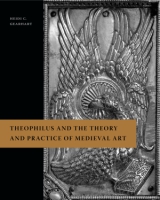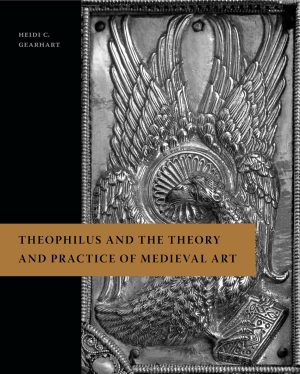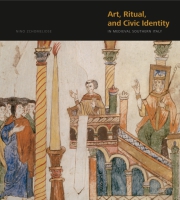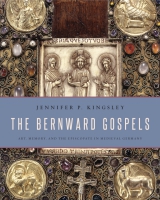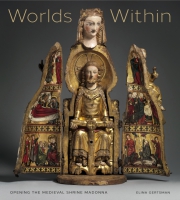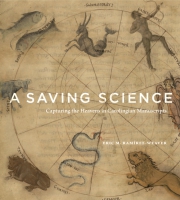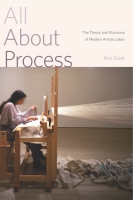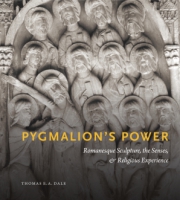Theophilus and the Theory and Practice of Medieval Art
Heidi C. Gearhart
“A significant and meaningful scholarly contribution to our understanding of the complexity of Theophilus’s approach and the Christian meanings imbedded within his prologues and instructions. Without a doubt, readers today will understand in new and fascinating ways the more profound role On Diverse Arts likely played for twelfth-century monastic artists and patrons alike.”
- Description
- Reviews
- Bio
- Table of Contents
- Sample Chapters
- Subjects
Written in northern Germany by a monk known only by the pseudonym Theophilus, On Diverse Arts is the only known complete tract on art to survive from the period. It contains three books, each with a richly religious prologue, describing the arts of painting, glass, and metalwork. Gearhart places this one-of-a-kind treatise in context alongside works by other monastic and literary thinkers of the time and presents a new reading of the text itself. Examining the earliest manuscripts, she reveals a carefully ordered, sophisticated work that aligns the making of art with the virtues of a spiritual life. On Diverse Arts, Gearhart shows, articulated a distinctly medieval theory of art that accounted for the entire process of production—from thought and preparation to the acquisition of material, the execution of work, the creation of form, and the practice of seeing.
An important new perspective on one of the most significant texts in art history and the first study of its kind available in English, Theophilus and the Theory and Practice of Medieval Art provides fresh insight into the principles and values of medieval art making. Scholars of art history, medieval studies, and Christianity will find Gearhart’s book especially edifying and valuable.
“A significant and meaningful scholarly contribution to our understanding of the complexity of Theophilus’s approach and the Christian meanings imbedded within his prologues and instructions. Without a doubt, readers today will understand in new and fascinating ways the more profound role On Diverse Arts likely played for twelfth-century monastic artists and patrons alike.”
“Gearhart's contribution, in particular her physical examination of the manuscript witnesses, the convincingly argued textual analysis and historical contextualization, and her model of process-aware ‘Theophilan viewing,’ will challenge and orient, with authority, future approaches to both Theophilus and, more broadly, the medieval work of art.”
“A sophisticated reading not only of Theophilus’s text but also of an array of twelfth-century art, enhancing our understanding of what art making and viewing meant in the Middle Ages. It engages with broader issues currently under discussion in the field: the notion of the individual artist, the religious dimensions of art, and the importance of memory in art, spirituality, and social relations.”
“Heidi Gearhart’s arguments about ‘free will,’ the morality of the correct manipulation of materials, the proper ornamentation of the church, the place of art, and even Theophilus’s use of words (diligenter) as found in De diversis artibus come together to create a picture of the role of the artist/artisan that is uniquely medieval and Christian. In sum, an object created by such an artist is a ‘trace’ of good behavior and witness to man’s participation in God’s creation.”
“Every student of medieval art has heard of Theophilus, and many have read On Diverse Arts, but few scholars have grappled with the true challenges of the text. Heidi Gearhart’s book opens this topic in new and exciting ways, bringing the complex political and spiritual landscape of Romanesque Germany into a fresh dialogue with the manuscripts and art objects associated with Theophilus and his circle. The result is a thoughtful, insightful, and deeply engaging discussion of On Diverse Arts, not merely as a manual for making art but rather as a richly rewarding document that sheds unexpected light on the social, artistic, and intellectual culture of twelfth-century Europe.”
“The key contribution of [Gearhart’s] study is to show how the treatise is much more learned than was previously thought while also deeply concerned with technical and practical matters.”
Heidi C. Gearhart is Assistant Professor of Art History at Assumption College.
Contents
List of Illustrations
Acknowledgments
List of Abbreviations
Introduction
1 Pedagogy and Exegesis
2 The Transformation of Matter
3 Monastic Labor and Craft
4 The Display of Skill
Conclusion: The Practice of Seeing
Notes
Bibliography
Index
Introduction
Theophilus—humble priest, servant of the servants of God, unworthy of the name and profession of monk—wishes to all, who are willing to avoid and spurn idleness and the shiftlessness of the mind by the useful occupation of their hands and the agreeable contemplation of new things, the recompense of a heavenly reward!
—Theophilus, On Diverse Arts, prologue I
Little is known about medieval artists, and few texts directly addressing the subject of art survive from the high Middle Ages. Largely functional, often religious, and lacking textual documentation, the images and objects of the Middle Ages seem to be in a world of their own, a contrast to the images and objects of the era of “art.” While the Middle Ages may serve as a foil to modernity in the popular imagination, the very characteristics that make medieval art something “other”—the lack of known artists, its functionality, its sacred character—have encouraged scholars to think about art in new ways. Concepts of originality, for example, or issues of physicality, performativity, agency, and power, have become subjects of study, enriching the field of art history as whole. While it is clear that concepts of the artist and art-making were rather different in the Middle Ages, what precisely those notions were remains largely unknown. The medieval artist is still a mysterious, shadowy figure. This book seeks to shed light on the subject and to discover the ideas, principles, and driving forces of craft and of art-making in the central Middle Ages.
This book is an argument not for an art theory of the Middle Ages, but for a distinctly medieval theory of art. It is an investigation into a system of values according to which artists operated and made objects. Previous scholars have written much about medieval aesthetic theory and the justification of imagery from a theological and Christian point of view, and this is invaluable. Precious little, however, is known about the very human act of making. Despite the paucity of sources and the lack of artists’ names, I argue in this book that medieval art-making was a subject of thought, of theorization, and of speculation. It was an intellectual as well as a physical activity, a blend of the ideal and the human. At its best, it was performed according to a deliberate set of principles, values, and expectations.
One of few witnesses to the theory and practice of medieval art is On Diverse Arts, the only complete treatise on art to survive from the central Middle Ages. Composed by a monk under the pseudonym Theophilus in the early part of the twelfth century, the treatise comprises three books that describe the arts of painting, glass, and metalwork. In clear, direct Latin prose, the author explains procedures for color mixtures and figure painting, glass dyes and window assembly, and the casting of chalices and liturgical objects. Each book begins with a prologue addressing religious themes, such as God’s creation of man or Solomon’s building of the temple.
Because of its rarity, the treatise has been treasured by scholars, but it is often read out of context, according to modern expectations. The very first line of the text feeds assumptions of medieval modesty. Theophilus, meaning “lover of God,” begins with a declaration of his subservience: “Theophilus—humble priest, servant of the servants of God, unworthy of the name and profession of monk—wishes to all . . . the recompense of a heavenly reward!” The instructions that follow have a strong practical bent and seem neither to obey any order nor to relate to the prologues. These characteristics have led many to liken the instructional chapters to cooking or medical recipes and to see the treatise as a compilation with no order or internal organization. Read as piously anonymous, disorganized, and practical, On Diverse Arts has thus been understood to confirm the assumption that medieval artists were humble, uneducated craftsmen: it has contributed to its own myth.
It was the author and poet Gotthold Lessing who brought On Diverse Arts to the attention of the academic community in the eighteenth century, when he cited it as evidence that the technique of oil painting was known in Germany long before the age of Jan van Eyck. Lessing’s argument was intended to counter Giorgio Vasari’s Lives of the Artists, which credited Van Eyck with the invention of oil painting, but his interest in the text went much further. As Robert Leventhal has shown, Lessing was highly interested in the gaps between ancient and modern thought, in the fissures and fractious relations between the two. Yet it was Lessing’s use of On Diverse Arts as a technical resource that set a pattern for later interpretations. In the next hundred years, the publications of Rudolph Raspe, Sir Charles Lock Eastlake, and Mary Merrifield brought the treatise to the attention of the English-speaking world, and their studies established Theophilus within a canon of texts treating artistic technique. French editions of On Diverse Arts were published around the same time. In German-speaking lands, it became a key text in the history and documentation of art through the work of the Vienna School, particularly that of Albert Ilg and Julius von Schlosser, who included Theophilus in their compilations and publications of primary source materials. These studies brought together a group of manuscripts and texts that addressed issues of artistic technique and categorized them as “recipe books.” In addition to On Diverse Arts, these include the Mappae clavicula (Little key to techniques); the De coloribus et artibus romanorum (On the arts and colors of the Romans), by a mysterious figure known only as “Heraclius”; and the Lumen animae (Light of the spirit). The Mappae clavicula, like On Diverse Arts, contains instructions for mixing pigments, making metal alloys, and dyeing glass. De coloribus et artibus romanorum also contains instructions for mixing pigments and coloring glass, as well as gilding silver, but an emphasis on chemical constitutions gives the text an alchemical cast. The Lumen animae, thought to derive in part from On Diverse Arts, is more encyclopedic. Similarities among these texts abound, and although scholars are still sorting out how the sources relate to one another, they are often discussed as a single genre. On the whole, they have been invaluable for the history of technique. Technical treatises, or treatises containing technical information, however, need not only serve this purpose. As Bernard Cerquiglini and others have shown, the functions of medieval texts could be fluid. One of the central tenets of this book is that cultural values are embedded in technical discourse, and that the manuscripts themselves are witnesses to how texts were read and to the values and functions they served.
Although it is a precious resource for the history of technique, On Diverse Arts remains little understood. It is uncertain why, or for whom, it was written, or how it was read. Like the idea of the medieval artist, the text may appear transparent—with its clear and concise prose, its practical instructions, and its religious utterances—but it resists easy interpretation. Self-effacing prose and practical descriptions may seem straightforward, but tropes of humility can belie considerable complexity. In addition, recent studies on the so-called minor arts have brought to light how greatly such small objects, like the censers, chalices, and book illuminations addressed by Theophilus, could evoke wonder for medieval viewers. Instructions, too, I argue, can reveal sophisticated value systems and agendas. Theophilus’s instructions contain significant gaps, often glossing over crucial steps of a procedure; his account of bronze casting, for example, says precious little about the important step of attaching sprues, or air vents, to the mold, making it difficult to believe the instructions were intended to teach on their own. Because images or other instructional diagrams are absent from the manuscripts, the text reads more as a literary work than an instruction pamphlet. Artists are implied, but not named; processes are described in detail, but images and final objects are not. These discontinuities put pressure on our assumptions about what an instruction manual should be and about what a medieval artist might be. While studies by Jeffrey Hamburger, Lawrence Nees, Robert Hanning, and others are invaluable and have done much to clarify ideas about medieval art-making, there is still much to be done.
This study begins with manuscript evidence: The surviving copies of On Diverse Arts are direct witnesses to how the treatise was read in the twelfth century. When manuscripts are read as physical artifacts, with a sensitivity to the interaction of medium and content, new insights emerge. We will read the text not according to modern paradigms of technical analysis, but, as much as possible, according to medieval patterns of thought. Erwin Panofsky once wrote that art theory arose only in the Renaissance, when texts shifted from being concerned with “how to do” something, as in On Diverse Arts, to articulating a philosophical position and methodological strategy, as in Leon Battista Alberti’s humanist tract On Painting. I argue otherwise. While it may be true that, by modern standards, there are no tracts on medieval art theory per se, in the twelfth century it was not unusual for practical questions to take on philosophical import. On Diverse Arts was of a piece with larger learning trends of its time, and the practical insights and philosophical content it yields are intertwined. Indeed, one of the fundamental premises of this study is that questions of “how”—instructions, recipes, practicalities—are not outside of philosophy but wholly subsumed within it.
For twelfth-century readers, particularly those educated in the monastic world in which Theophilus’s treatise circulated, theory and practice existed in a dialectical relationship. Hugh of St. Victor, master and teacher at the Augustinian abbey of St. Victor in Paris and one of the most influential thinkers and teachers of the period, made it a point to explain the relationship of theory and practice in the Didascalicon, his treatise on education and reading. According to Hugh, the theoretical is that which is speculative, while the practical is that which is active, and although the two may appear to be different, theoretical speculation and practical action are both elements of the larger field of philosophy. This understanding of theory and practice resolves the seeming conflict between the religious prologues and practical instructions of On Diverse Arts, which have often been thought to serve entirely different agendas or even to have been written separately. Once we understand theory and practice as interrelated manifestations of philosophy, we begin to see the prologues and instructions as interdependent. Through them, On Diverse Arts describes an ideal mode of behavior and set of actions: Proper practice is defined by theory, and theory is defined by proper practice. Neither exists without the other. It is a rather different conception from the theoretical treatises considered by Panofsky, but it is a philosophical framework nonetheless, and in this book I explore the medieval—and Theophilan—concepts of theory and practice. When we take the medieval, and particularly twelfth-century, ideas of theory and practice seriously and read prologues and instructions together, a cogent system of art begins to emerge.
It is a major contention of this book that the person of the artist, the practice of craft, and theories of art-making are historically situated; conceptions of artists and their work were by no means consistent through the many centuries that are dubbed the Middle Ages. Paul Binski has suggested that when “God himself appears as some sort of artificer, it is as a dividers-wielding architect or conditor . . . not as a goldsmith: saints or monks, not God, were workers in Gold.” While his differentiation of media is apt, such images of God as artist, as architect, or as creator in the artistic sense were fleshed out in the later Middle Ages, and did not exist in the earlier period. The change seems to accompany a shift in the status of artists, and while the contours of that shift are yet to be drawn, it seems likely that Theophilus’s text was written in the midst of this changing world.
This study will thus approach On Diverse Arts within its own historical context. Scholars generally agree that the treatise was written in northern Germany, near Cologne or farther to the east, near Paderborn, and that Theophilus was a Benedictine monk. It was probably composed in the first third of the twelfth century, or around 1120; the two earliest manuscript copies of the text date to some decades later, around the middle of the century. Both have some connection to a Benedictine monastery, and both can be localized to the region stretching from the lower Rhine to the Weser River Valley. These manuscripts will form the basis of this study.
The first, now in Wolfenbüttel, is known to have come from Cologne, for it contains an ex-libris from the Benedictine monastery of St. Pantaleon, one of the wealthiest and best-known abbeys of the city. The second, now in Vienna, has a less certain provenance but was likely written in the region around Paderborn, a bishopric within the archdiocese of Mainz and home to the Benedictine abbey of Abdinghof. A third manuscript, younger than the other two, is of even less certain provenance but continues the pattern. Once owned by Lord Harley and now in the British Library, it dates to the late twelfth century, and although its origins are unknown, its script is characteristic of northern Germany.
The next three copies show patterns of transmission. One, now in Brussels, dates to the end of the twelfth century or the beginning of the thirteenth and was written in the region of Liège. The following two copies date to the early thirteenth century and come from England. The presence of early copies there is not surprising, since northern Germany and the Meuse valley had close trading ties with England in the period. Thereafter, the geographical path of transmission is more difficult to trace. Three “nearly complete” manuscripts containing all three books and most of the prologues survive from the fourteenth and fifteenth centuries; they come from Saxony, the Rhineland, and Italy. Five more cover a similar date range and contain at least two-thirds of the book, while another eight contain excerpts of varying length.
Three existing copies date to the seventeenth century, and two to the nineteenth; all were made under the auspices of book collectors. Two of the seventeenth-century manuscripts are copies of the oldest twelfth-century manuscripts and were mostly likely produced at the library of the medical doctor and book collector Bernhard Rottendorff, who owned the Vienna manuscript. The third was made for Henry Wanley, advisor to the great collector Lord (Edward) Harley; it is a copy of a partial manuscript now in Cambridge. Charles de l’Escalopier, who owned a fifteenth-century copy of the text, had two additional copies of the manuscript made, probably in preparation for his translation of Theophilus published in 1843. One copy, completed in 1841, was ordered by J.-Marie Guichard and written by a certain M. Baker; the other is a duplicate, a less fine copy of Baker’s text, which was included in a volume of the letters of Saint Paul and a text on glass. Both manuscripts are now in Amiens. In all, twenty-seven manuscript copies of On Diverse Arts survive, and they range widely in date, completion, and place of origin.
The manuscripts have received relatively little scholarly attention; only recently has there been a growing awareness of the importance of evidence contained in the extant manuscript copies of the treatise. This book focuses on the earliest surviving copies: the two oldest, at Wolfenbüttel and Vienna; Cambridge, University Library MS Ee. 6.39; and London, BL Harley MS 3915. These manuscripts reveal possibilities for how twelfth-century readers might have understood the treatise, particularly in the Benedictine sphere of northern Europe.
Theophilus has long been identified with the early twelfth-century goldsmith Roger of Helmarshausen. This attribution is largely based on an inscription in the Vienna manuscript that reads Theophilus, qui et Rogerus (Theophilus, who is Roger). Roger, in turn, is known through the survival of a document that probably dates to the late twelfth century but claims a date of 1100. Here Roger is named as the artist of a scrinium, or box, made for the bishop Henry of Werl of Paderborn. We do not know for certain whether Theophilus was actually Roger, and it is not the purpose of this study to determine the identity of Theophilus. The identification has in fact been problematic, for it encourages assumptions that the treatise is a practical resource, written by a craftsman with little sophistication. Theophilus may well have been Roger; he may also have been someone in Roger’s circle. The point is that On Diverse Arts is far more learned than previous scholars have recognized. The possibility that art-making and learned writing were not mutually exclusive is a driving force of this study. In order to keep as close as possible to the historical and geographical context of On Diverse Arts, objects attributed to Roger and to his milieu form the corpus of this book and serve as case studies to test and build upon the principles articulated in the treatise.
The Context
The Benedictine abbeys in which Theophilus’s treatise circulated were some of the wealthiest and most learned institutions of the region. They were also closely tied to imperial powers and had long traditions of art production, as well as sizeable libraries and schools. The abbey of St. Pantaleon, for example, was founded by a monk from St. Maximian, in Trier, an abbey known for its production of manuscripts and metalwork. It was also the burial site of the empress Theophanu and the archbishop Bruno of Cologne, brother of Otto the Great. In Paderborn, the Benedictine abbey of Abdinghof was founded by the bishop Meinwerk, named bishop of Paderborn by the emperor Henry II. Liège was home to the well-established monastic school of Saint-Laurent, where Rupert of Deutz studied and later taught before becoming abbot at St. Heribert’s in Deutz, just outside of Cologne. One of Rupert’s students in Liège was Wibald, who would become the abbot of Stavelot and a great patron of art. Stavelot was an independent principality, and Wibald served multiple roles in the empire. He was an advisor to the emperor Conrad III and Frederick Barbarossa and served as abbot to nearby Malmedy as well as Corvey, on the Weser, an abbey founded by Charlemagne. He was even, for a short time, abbot of Montecassino. Stavelot had been reformed in the eleventh century by the abbot Poppo, who had been appointed to the position by the emperor Henry II in 1020; in the following years Poppo’s reforming activities spread, and he is credited for the reforms of the abbeys of St. Maximian in Trier, Saint-Laurent in Liège, and the imperial abbey of Echternach, in present-day Luxembourg.
The abbeys were thus enmeshed in a network that was not only religious but also political and economic. As Tjamke Snijders has shown, relations among personnel could also be fickle, changing quickly in an unstable political environment. In such an environment, allies were all the more important. Connections between abbots, ecclesiasts, and the local aristocracy made possible the easy and frequent exchange of personnel, learning, and books and certainly facilitated the exchange of art objects, relics, and probably even artists themselves. In 1107, for example, Helmarshausen acquired the relics of Saint Modoaldus, archbishop of Trier and advisor to King Dagobert of France, from the abbey of St. Maximian in Trier. The procession passed through Cologne and St. Pantaleon, and a cross now in Cologne was perhaps made for the occasion by Roger of Helmarshausen. Roger, too, may have traveled, as his name is remembered at a number of monasteries along the route, including St. Pantaleon and the abbey of Helmarshausen.
The twelfth century was indeed a century of change. As Ute-Renate Blumenthal has pointed out, the imperial support of monasteries that took place in the eleventh century in the name of reform was also the basis of precisely the conflicts that were so problematic in the investiture crisis, and which continued to play out in the twelfth century. The abbey of Saint-Laurent in Liège, for example, went through periods of reform, as under Poppo, but because it was never placed under the authority of a mother house, as in the Cluniac system in France, the death of one charismatic, reform-minded leader did not necessarily mean that reform continued under his successor.
These Benedictine abbeys were thus deeply embedded in the political system and often had to take sides. In the late eleventh century, for instance, Henry II of Werl-Arnsberg was made bishop of Paderborn by Emperor Henry IV, in effect usurping the See from Henry I, count of Assel, who had been installed by Henry’s rival Hermann of Salm, king of the Swabians and Saxons. In a shrewd political move, Henry of Werl seems to have then commissioned a portable altar, now in Paderborn, which, according to a charter of the late twelfth century, was made by Roger of Helmarshausen. The altar depicts Henry of Werl as a successor to Bishop Meinwerk, who had been installed by Emperor Henry II, but had in fact caused problems for the counts of Werl in his attempts to secure independence from lay control. Probably made around 1105, the altar may be seen as an attempt to legitimize the position of the bishop and solidify ties to the imperial court. It thus highlights the shifting alliances and changing political power of the early twelfth century. In this context, the production of art and trade of relics could be usefully employed as political tools.
Pressures for monastic reform persisted into the twelfth century and came increasingly from outside the Benedictine realm. While the eleventh-century reform movements of Gorze and Cluny had largely been absorbed into the preexisting monastic fabric, the Cistercians and the Carthusians gained large numbers of converts in the twelfth century, in Germany and Belgium as well as in France. Even if, as Van Engen has suggested, the Benedictine houses were less threatened by this second wave of reform, the Cistercians’ growing presence in the Rhine-Meuse region in the twelfth century reflects the economic and spiritual pressures of the time. The Cistercians were founded at Cîteaux in 1098, and by the early twelfth century their numbers were quickly increasing. Much of their growth was due to the conversion of older monastic houses—five abbeys in the region of Liège alone were founded or transferred to the Cistercian order in the span of just sixteen years, from 1132 to 1148. The abbey of Orval was a case of such transfer. Founded in 1070 by Calabrian Benedictines and home to a house of canons regular from around 1110, it was taken over by the Cistercians in 1132, becoming the first abbey of the order in Belgium.
The growing presence of Cistercian monasteries was noted by writers of the time. The author of a small book known as the Libellus de diversis ordinibus et professionibus qui sunt in Aecclesia, for example, described the different monastic orders active in the region of Liège in the early twelfth century, including Cistercians alongside Benedictines, discussing the habits and strengths of each and treating the different orders with an even hand. The Libellus de diversis ordinibus and the case of the monastery of Orval reveal a rapidly changing monastic landscape in the region of the Rhine-Meuse. Yet as Giles Constable has shown in his edition of the Libellus, the book also reveals a surprising tolerance and awareness, an understanding that monasticism could take different forms and have different priorities, and a remarkable willingness to agree to disagree.
Theophilus probably knew of the Cistercian order, its asceticism, and its critique of art; indeed, On Diverse Arts was written in a context where the very notion of monasticism was a subject of discussion. But while some early scholars interpreted On Diverse Arts as a direct response to the growing Cistercian order, and even specifically to the Apologia of Saint Bernard of Clairvaux, there is no evidence that this was the case. It is perhaps more accurate to view the two texts as responding to similar concerns in different ways. Many of the anxieties about art-making in the period extend back into antiquity and have to do with fundamental issues of Christianity and the status of the image and the visibility of God. As Conrad Rudolph has shown, Bernard’s objections to art were not only doctrinal but also economic, social, and spiritual. Theophilus’s treatise takes on some of the same objections to art. He answers them, however, quite differently, particularly with regard to devotional practice, liturgy, and spirituality. On Diverse Arts may not be a direct response to Bernard of Clairvaux, but it is part of the broader conversation about the status and function of art and its production.
The overarching context of debates about art is closely related to economic changes that were occurring all over Europe, and especially in northern Europe, in the twelfth century. There were two relevant economic shifts, no doubt related: a growth in the market economy and a change in the status of the artist. It is well known that the Benedictine abbeys had long been large landowners, with enormous power and prestige in what was a primarily agrarian economy. Accordingly, many artisans and laymen were doing business mainly on behalf of the local abbey. As the twelfth century progressed, however, trade became increasingly weighted in cities, and merchants and tradesmen did business on their own.
The city of Liège is a good example. In the tenth and eleventh centuries, Liège grew significantly. A new city wall built by the bishop Notger around the year 1000 encompassed both the old “Holy City,” with the cathedral and bishops’ palace, as well as a newer part of town to the south. Known as the vicus novus, this neighborhood was a commercial district that bordered the market, effectively expanding it. The district must have been successful, because merchants from the vicus novus in Liège are mentioned in a late tenth-century toll tariff of London and an eleventh-century toll tariff from Koblenz; these merchants were known, too, at the markets of Cologne. In 1107 the merchants of Liège even gained their own market prerogative, or judicium forense, which allowed them further independence and mobility. The nearby city of Huy rivaled Liège in economic activity. Huy established its own city charter in1066 and purchased a “limitation of seignorial rights” from the bishop. It had thus been home to merchants far earlier, and with its river access it became a center for trade. Clearly the region was undergoing significant economic change in the late eleventh century and into the twelfth. These developments were both a boon to the monasteries and a threat, for as the cities grew, the abbeys gradually lost their economic control.
At the same time, there is evidence that in the early part of the twelfth century, artists moved from one abbey to another, as Roger of Helmarshausen seems to have done. Few names are known, but workshop styles emerge and disperse. The characteristic V-fold style attributed to Roger seems to reach its height at the abbey of Helmarshausen in the first decades of the century, and reminiscences of that style may be detected in later objects like the shrine of Godehard at Hildesheim and in manuscripts made for the cathedral of Lund, in Norway. Most evidence that survives for the names of twelfth-century artists dates from the later part of the century, even if it refers to artists from many decades earlier. This is the case with Roger, whose name and profession is known only from the late twelfth-century charter describing the altar of Henry of Werl. By the end of the twelfth century, more artists’ names survive. As Enrico Castelnuovo has aptly described, the task of studying the persona of the artist is fraught with uncertainty. The artisan Godefried, of Huy, for example, was remembered in the late twelfth-century necrology of the abbey of Neufmoutier as “Godefried, goldsmith, our brother . . . was burgher of Huy, later he became a canon and our brother. He was not superseded in the art of metalwork, by any artist of his time; he made a large number of reliquaries, shrines of saints in different lands, vases and other objects for the use of kings.” The economic history and scattered evidence of artists’ names, then, seems to suggest that over the course of the twelfth century, art-making became increasingly professionalized, practiced more and more by artisans in burgher towns like Huy or cosmopolitan centers like Liège. The cultural values and the historical context that drove these developments is less well understood, as is the shift in conception of the artist. On Diverse Arts is a precious resource in this regard, for it seems likely to have been written precisely in this era and may even have been precipitated by these changes. It is an articulation of the values of artisanship in a shifting world.
Twelfth-century trends in learning and education also affected the kinds of texts being written and the nature of those texts. There have been many explanations for these changes in learning, for while they were partly a response to a new influx of texts from the East, they were also fostered by the needs of growing cities, with their new mercantile infrastructure, and the political upheavals and tensions of the investiture crisis. Cathedral schools trained new generations of ecclesiastical officers, and by the mid-twelfth century schools were becoming universities, as at Paris in 1160 and Montpellier in 1180.
The Rhine-Meuse region had been famous for its schools and masters since the Carolingian period. Liège in particular was home to a famous cathedral school in the eleventh century and into the beginning of the twelfth, a tradition begun under the master Notker of Liège and continued by his pupil Wazo of Liège. In the twelfth century it was also home to Reimbald of Liège, canon of the cathedral and possibly the author of the Libellus de diversis ordinibus. The nearby Benedictine abbey of Saint-Laurent had its own lineage of scholars: Adlemann, a student of Fulbert of Chartres, was the teacher of Lambert of Liège, who wrote the first version of the vita of Saint Heribert, later to be revised by Rupert of Deutz, himself a student of the monastic school. Figures like Adelmann and Wazo were renowned for their virtue, manners, and eloquence; as C. Stephen Jaeger has shown, these men were some of the great exemplars of eleventh-century charismatic teachers. Rupert, too, has long been seen as continuing this tradition, though his work is interesting precisely because it links together the concern for mores and virtu with the rigorous allegories of early scholasticism. Theophilus’s fine Latin may be just one piece of evidence that he was educated in this milieu; tensions within On Diverse Arts may also echo this moment of transition.
Seen within the monastic, literary, and pedagogical sphere of the twelfth century, On Diverse Arts emerges as an articulation of a particular mode of thought, an agent and expression of a twelfth-century world. Echoes and insights emerge from reading On Diverse Arts alongside works by other scholastic writers of the period, particularly Hugh of St. Victor and Rupert of Deutz. Both Hugh and Rupert were well known in the region as writers and as teachers—their texts circulated amongst local abbeys—and Rupert is thought to have been involved in art as well. Situated within the discursive structures of twelfth-century thought, Theophilus’s practice of writing, his mode of thinking, and his manner of describing techniques shed new light on twelfth-century values of art and art-making.
In the midst of political, economic, and religious uncertainty, Theophilus defines and defends artistic production. On Diverse Arts reveals the pressures of a twelfth-century world undergoing significant cultural change, and these pressures may well have been the motive for the composition of the text. Theophilus’s treatise is neither recipe book nor religious polemic; his voice is distinct, both in its mode of argument and its ideas. It is precisely by aligning theory and practice that the treatise assigns moral value to the materiality, function, and labor of sacred art. As we shall see, larger questions of the status of art are revealed in smaller questions about technique and spirituality. A re-reading of On Diverse Arts suggests a new mode of organizing our categories of twelfth-century art; it also suggests that while art operated primarily on a local level, it was nonetheless part of a much larger cultural discourse. Therefore even inconsistencies and oddities in On Diverse Arts are informative, for they reveal a changing world of artistic practice, foreshadowing larger transformations to come.
Overview of the Chapters
This book is organized around a series of manuscript readings. Evidence from these rich volumes guides a search for correspondences and patterns within the text, bringing to light the structures organizing the treatise and its major concerns: pedagogy, materials, labor, form, and vision. An exploration of these themes guides each chapter. Together, the themes shed light on artistic practice in the period.
The first chapter introduces the structure and narrative of Theophilus’s text and argues against the traditional reading of On Diverse Arts as a “recipe book.” The examination begins with the Wolfenbüttel manuscript, in which an eleventh-century copy of Vitruvius’s On Architecture is followed by Theophilus’s On Diverse Arts. This copy of Theophilus’s text creates a harmony with that of Vitruvius, suggesting the treatise be read within a broad context of Latin literature. Theophilus’s fundamental project, I find, is to define art as a learned and spiritual discipline. I show that the treatise follows a careful structure and that its narrative echoes Augustinian thought, while Theophilus’s use of prologues and his embrace of pedagogy places him in a literary tradition that builds on classical thought and may be seen as parallel to Hugh of St. Victor and John of Salisbury. On Diverse Arts therefore emerges as part of a scholarly endeavor that links the “moderns” to the ancients, appropriating sources from antiquity and systematically defining a philosophy of artistic practice.
In the second chapter, I suggest that, for Theophilus, art is the transformation of material and is justified by the notion of utilitas, or usefulness. Textual evidence links Theophilus’s interest in material to a literary tradition stretching from Pliny to Isidore of Seville, while manuscript evidence suggests we read Theophilus in the context of twelfth-century texts like the Liber Floridus. His emphasis on metals also has great local significance, since abbeys like Stavelot and Helmarshausen were engaged in mining and the metals trade. Theophilus’s treatise aims to justify a profoundly materialist practice as a religious enterprise. It was written just as European culture was experiencing an increasing split between religion and commerce, with urban mercantile economies growing rapidly and ascetic monastic communities becoming increasingly numerous and vociferous. Theophilus declares mining and materialism to be sacrosanct and suggests that art serves God because it transforms earthly materials into useful, even sacred, objects. His argument reaches beyond traditional defenses and brings new complexity to the monastic movement’s justification of wealth.
The third chapter looks at Theophilus’s concept of labor and the spirituality of manual work. His instructions, usually dismissed as only technical, are shown to be carefully written, following patterns of exegetical thought and taking much from Saint Augustine. Theophilus defines skill in terms of knowledgeable and virtuous action so that art-making becomes the exercise of rationality, morality, and free will—it helps man exercise the full potential of his humanity and restore him to God. Invoking the biblical Beseleel as a typological precedent, Theophilus inverts the usual criticism of Jewish embellishment; the objects made by Beseleel pleased God because his skill was a manifestation of the work of the Holy Spirit. Most scholars have understood Theophilus’s allusion to man as imago Dei and his invocation of Beseleel as straightforward justifications of art through biblical exemplars. I see it rather differently. Both allusions are in fact integral parts of a far more sophisticated theory of production, where art is justified by the process through which it is made. At a time when the old Benedictine agrarian and imperial patronage system was facing competition from a new mercantile economy and increasing numbers of lay artisans, Theophilus created a theory of artistic work based on sophisticated Augustinian and Benedictine spirituality. On Diverse Arts changes our very conception of the art object; it is no longer a finished, self-contained thing but an analogy for man’s fallen status and the process of restoration.
The fourth chapter examines how such an emphasis on technique might have repercussions for a sense of form. Beginning with the Vienna manuscript, the chapter looks at the values of variety, moderation, and decorum espoused by Theophilus and how they are made manifest in objects attributed to Roger of Helmarshausen. From this examination, we begin to see that Theophilus’s reticence regarding iconography and his vague allusions to ornament tell us much about the parameters of art-making. Abstract formal qualities take on new meaning as evidence of workshop consistency, traces of good practice, and witnesses to ingenuity.
Taking each theme in turn, the book slowly builds a theory of art that changes how we understand Theophilus’s treatise, medieval liturgical art, the history of art theory, and the story of artists. Objects emerge throughout as test cases and take center stage in chapter four. In the conclusion, I bring the themes together and clarify Theophilus’s broad concepts of artistic production, proposing a corresponding theory of vision. I confront the assumption that medieval art had no discourse, or that it is to be understood primarily in anthropological or socio-historical terms. Jeffrey Hamburger has recently noted that theology and visual artifacts constitute separate discourses; images do something far more than visualize theology. Rather than attempting to make the two equivalent, or make one explicate the other, Hamburger suggests we view theology and religious discourse as “less a body of doctrine than itself a variety of methods.” Similarly, through On Diverse Arts, we discern how ideas about theology, learning, and materiality echo and speak to one another in the making of an object. On Diverse Arts articulates an orderly structure for the discipline of art, creating an ideal and establishing the terms by which it is to be made. Material, labor, and modes of working are all deeply theorized and self-consciously understood. Furnishings of the church, for example, are not simply embellishments or luxuries; they also carry spiritual, cosmological, and institutional significance. Through the lens of On Diverse Arts, the art object begins to be seen as the result of the process by which it is made.
Theophilus’s justification of art goes far beyond what scholars have heretofore seen. His treatise is embedded in the exegetical and pedagogical philosophy of the time, laden with knowledge of the ancients. He proves that art is part of the realm of learning, and he shows us that medieval artistic practice was indeed self-aware, even self-serving. Understood as a part of the larger intellectual context of the twelfth century, and read as a learned treatise, On Diverse Arts helps us to see medieval art on its own terms.
Also of Interest
Mailing List
Subscribe to our mailing list and be notified about new titles, journals and catalogs.
